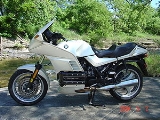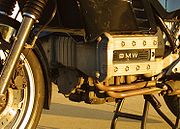
BMW K100
Encyclopedia
The BMW K100 is a family of four-cylinder 987 cc motorcycle
s that were manufactured by BMW
from 1983 to 1992.
In combination, this meant that BMW's marketing to users of a superior bike, allowing them to price at a premium, was being quickly lost, resulting in a loss of sales and market share.
had developed a flat-four boxer for the GL1000 Gold Wing, guided the design team led by Josef Fritzenwenger and Stefan Pachernegg to an existing liquid-cooled Peugeot
car engine.
To speed development but improve the engine, the team made two key choices. Firstly, as a car engine, it was relatively large (most specifically wide, but also tall) compared to a motorcycle engine. As BMW needed something different from every other manufacturer, the choice was made to lay the engine flat in the frame to keep the centre of gravity low and improve the bike's handling. This is known as a longitudinal four because the crankshaft is in line with the direction of travel of the motorcycle. This configuration, although technically not new for motorcycles, had not been seen for many years, and overcame the problem of necessitating a horsepower-robbing 90-degree turn to the driveshaft. The second development took place around engine management, with Bosch
L-jet fuel injection, and later, Motronic
fuel injection replacing carburettors, increasing power, broadening and smoothing the powerband and reducing fuel consumption.
These engineering choices meant that from start they had a solid-performing and marketable product, and the K100 was on the market and being sold within four years.
The same team would later develop a three-cylinder version of the engine for the 750 cc K75
, and an improved four-valve-per-cylinder head for the aerodynamic K1
.
 The engine has its four cylinders arranged so that the crankshaft is on the right-hand side of the motorcycle, with the cylinder heads, camshafts, injectors and spark plugs on the left-hand side. This arrangement keeps the centre of gravity relatively low, which benefits handling; and the space behind the front wheel available for the radiator.
The engine has its four cylinders arranged so that the crankshaft is on the right-hand side of the motorcycle, with the cylinder heads, camshafts, injectors and spark plugs on the left-hand side. This arrangement keeps the centre of gravity relatively low, which benefits handling; and the space behind the front wheel available for the radiator.
In addition, since the crankshaft is now on the right-hand side, access to the engine becomes much easier than in a conventional design, where the crankshaft is at the bottom. BMW preferred a shaft-drive for smoothness, and a single-sided hollow swing arm enclosing the drive shaft provided right side drive through the gearbox and to the rear wheel. The 4-into-1 all stainless steel exhaust exited on the left hand side.
Brakes were twin-pot Brembo
onto undrilled discs. Two different forks manufactures were used: Showa with an outer upper tube diameter of 1.612 in (41 mm) and Fichtel and Sachs measuring 1.627 in (41 mm). In later models, the standard swingarm was replaced with a Paralever just as on the K1.
All models have dual front, and single rear disk brakes. The RS model has a longer gear ratio than other models.
The K-series offered additional refinements including: all stainless steel exhaust, rust-resistant aluminium fuel tank (although tanks do rust at the low points on right and left sides), anti-lock brakes or ABS on later-year models, adjustable headlight, high capacity 460 watt alternator, Hella accessory plug-in, self cancelling signal lights.
. The K100 was a relative sales success, stemming the losses to the Japanese and changing the media and public perception of BMW.
The four-cylinder engine suffered from secondary vibration, but the three-cylinder K75 was far smoother. The engineers had anticipated this, and had designed in excellent vibration isolation, but it was the only technical glitch.
The competition were never far behind in performance on launch, updates were modest, while engine performance was stepped up with the September 1988 launch of the radically aerodynamic BMW K1
.
Motorcycle
A motorcycle is a single-track, two-wheeled motor vehicle. Motorcycles vary considerably depending on the task for which they are designed, such as long distance travel, navigating congested urban traffic, cruising, sport and racing, or off-road conditions.Motorcycles are one of the most...
s that were manufactured by BMW
BMW Motorrad
BMW Motorrad is the motorcycle brand of the German company BMW, part of its Corporate and Brand Development division. The current General Director of the unit is Hendrik von Kuenheim....
from 1983 to 1992.
Background
As the 1970s came to an end, BMW faced three problems from developing its flat-twin boxer engine further:- Developing European UnionEuropean UnionThe European Union is an economic and political union of 27 independent member states which are located primarily in Europe. The EU traces its origins from the European Coal and Steel Community and the European Economic Community , formed by six countries in 1958...
emissions regulations meant that more control was needed over the amount of fuel entering the combustion chamber. From an engineering standpoint this was easier to achieve with more cylinders at an overall smaller displacement. - The market-led development of bikes was leading to the Japanese factories developing smoother and quicker machines based around a four-cylinder format.
- Bike comparison in the media at the time was based around top speed, and a four-cylinder when fully developed created more power.
In combination, this meant that BMW's marketing to users of a superior bike, allowing them to price at a premium, was being quickly lost, resulting in a loss of sales and market share.
Engine
The need for a quick development time scale of a clean burning four-cylinder engine and the fact that HondaHonda
is a Japanese public multinational corporation primarily known as a manufacturer of automobiles and motorcycles.Honda has been the world's largest motorcycle manufacturer since 1959, as well as the world's largest manufacturer of internal combustion engines measured by volume, producing more than...
had developed a flat-four boxer for the GL1000 Gold Wing, guided the design team led by Josef Fritzenwenger and Stefan Pachernegg to an existing liquid-cooled Peugeot
Peugeot
Peugeot is a major French car brand, part of PSA Peugeot Citroën, the second largest carmaker based in Europe.The family business that precedes the current Peugeot company was founded in 1810, and manufactured coffee mills and bicycles. On 20 November 1858, Emile Peugeot applied for the lion...
car engine.
To speed development but improve the engine, the team made two key choices. Firstly, as a car engine, it was relatively large (most specifically wide, but also tall) compared to a motorcycle engine. As BMW needed something different from every other manufacturer, the choice was made to lay the engine flat in the frame to keep the centre of gravity low and improve the bike's handling. This is known as a longitudinal four because the crankshaft is in line with the direction of travel of the motorcycle. This configuration, although technically not new for motorcycles, had not been seen for many years, and overcame the problem of necessitating a horsepower-robbing 90-degree turn to the driveshaft. The second development took place around engine management, with Bosch
Robert Bosch GmbH
Robert Bosch GmbH is a multinational engineering and electronics company headquartered in Gerlingen, near Stuttgart, Germany. It is the world's largest supplier of automotive components...
L-jet fuel injection, and later, Motronic
Motronic
Motronic is the trade name given to a range of digital engine-management systems developed by Robert Bosch GmbH, commonly known as Bosch.-Motronic ML1.x:Motronic ML1.x was one of the first digital engine-management systems developed by Bosch...
fuel injection replacing carburettors, increasing power, broadening and smoothing the powerband and reducing fuel consumption.
These engineering choices meant that from start they had a solid-performing and marketable product, and the K100 was on the market and being sold within four years.
The same team would later develop a three-cylinder version of the engine for the 750 cc K75
BMW K75
The BMW K75 was a standard motorcycle produced by BMW Motorrad from 1985 to 1995. At the time of its introduction, the K75 was BMW's cheapest motorcycle...
, and an improved four-valve-per-cylinder head for the aerodynamic K1
BMW K1
The BMW K1 is a motorcycle that was designed by BMW as a high-speed sports-tourer, designed to change the motorcycle media and buying public's mind of BMW as only a manufacturer of flat-twin tourers....
.
K100

In addition, since the crankshaft is now on the right-hand side, access to the engine becomes much easier than in a conventional design, where the crankshaft is at the bottom. BMW preferred a shaft-drive for smoothness, and a single-sided hollow swing arm enclosing the drive shaft provided right side drive through the gearbox and to the rear wheel. The 4-into-1 all stainless steel exhaust exited on the left hand side.
Brakes were twin-pot Brembo
Brembo
Brembo S.p.A. is a manufacturer of automotive brake systems, especially for high-performance cars and motorcycles. It was established in Bergamo, Italy in 1961. Soon after the company was formed, it specialised in disc brakes, which were exclusively imported from the United Kingdom at the time...
onto undrilled discs. Two different forks manufactures were used: Showa with an outer upper tube diameter of 1.612 in (41 mm) and Fichtel and Sachs measuring 1.627 in (41 mm). In later models, the standard swingarm was replaced with a Paralever just as on the K1.
Model designations
Various models of the K100 were produced.- K100, with no fairing.
- K100RS, with sports fixed fairing and lower bars.
- K100RT, with full fairing for 'road touring'.
- K100LT, with a higher screen and additional equipment as standard for 'Luxury Touring'.
All models have dual front, and single rear disk brakes. The RS model has a longer gear ratio than other models.
The K-series offered additional refinements including: all stainless steel exhaust, rust-resistant aluminium fuel tank (although tanks do rust at the low points on right and left sides), anti-lock brakes or ABS on later-year models, adjustable headlight, high capacity 460 watt alternator, Hella accessory plug-in, self cancelling signal lights.
Sales
Although sales were initially modest, buyers eventually warmed to the multi-cylinder BMW, and the three-cylinder derivation in the form of the BMW K75BMW K75
The BMW K75 was a standard motorcycle produced by BMW Motorrad from 1985 to 1995. At the time of its introduction, the K75 was BMW's cheapest motorcycle...
. The K100 was a relative sales success, stemming the losses to the Japanese and changing the media and public perception of BMW.
The four-cylinder engine suffered from secondary vibration, but the three-cylinder K75 was far smoother. The engineers had anticipated this, and had designed in excellent vibration isolation, but it was the only technical glitch.
The competition were never far behind in performance on launch, updates were modest, while engine performance was stepped up with the September 1988 launch of the radically aerodynamic BMW K1
BMW K1
The BMW K1 is a motorcycle that was designed by BMW as a high-speed sports-tourer, designed to change the motorcycle media and buying public's mind of BMW as only a manufacturer of flat-twin tourers....
.

